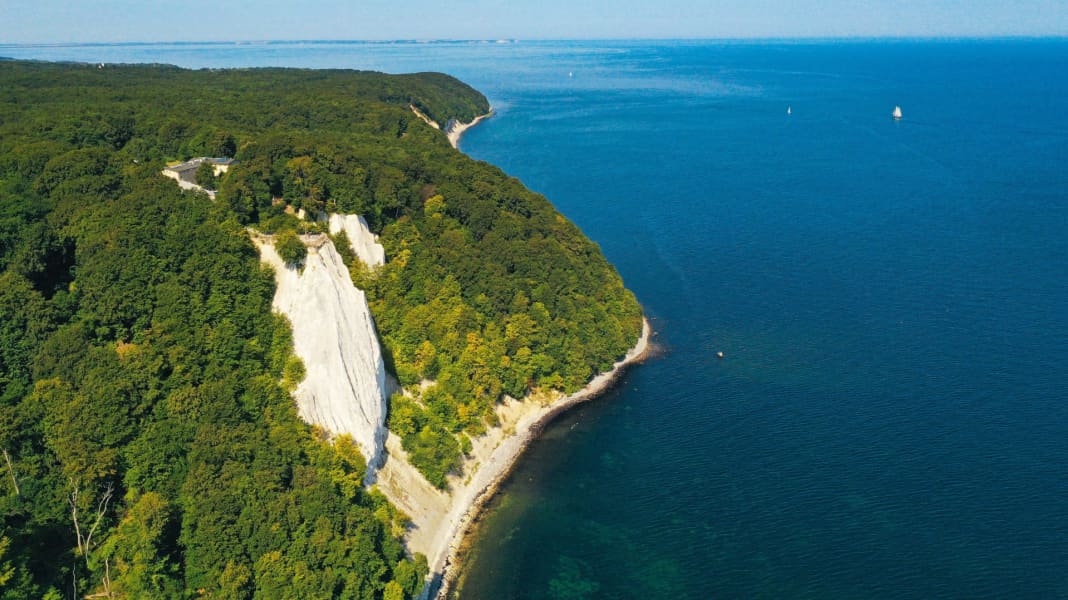
We present these harbours on and around Rügen
Germany's largest island is enormously diverse. Accordingly, it is very popular with tourists. In contrast to land-based holidaymakers, sailors have the chance to avoid the hustle and bustle by making a clever choice of destinations and enjoy all the outstanding sights of Rügen, including neighbouring Hiddensee and the old Hanseatic towns on the Strelasund and Greifswald Bodden, in peace and quiet. Just make sure you have enough time: Two holiday weeks are not too short for a relaxed circumnavigation of Rügen.
On the one hand, it is the incredible diversity - from the green Bodden coast to the seemingly endless sandy beaches on the outer coast to the breathtaking white chalk cliffs - that makes the region so unique. In addition, there are countless testimonies from ancient and more recent times, historical buildings, spectacular museums - and all this in the midst of a magnificent, maritime cultural landscape.
If you have your home port in the region, you have an advantage. From Stralsund, Greifswald or Kröslin, it is only a few nautical miles to the first great destination. Sailors from Schleswig-Holstein, on the other hand, first have to complete two to three day trips to the island. If you don't want to sail through the night, you will usually make stopovers, for example in Wismar and Warnemünde. Arrival and departure then quickly add up to a third week's holiday. Finally, there is also the option of exploring the area with a charter yacht hired locally.
Cape Arkona as a sticking point in the cruise planning
Whether on your own keel or someone else's, the question for everyone is whether it is better to sail round Rügen clockwise or anti-clockwise. In view of the sometimes long-lasting high-pressure conditions with rather weak winds that dominated the summer of 2022, this was basically irrelevant. However, if unstable weather and strong winds are to be expected, you should plan ahead. Then it all depends on what weather the crew is expecting at Cape Arkona. The northernmost tip of the island can turn out to be a weather kitchen with an unpleasant chop effect, currents and high swell. If there is a lot of wind from the north-west, you should therefore sail around the cape from west to east, and the other way round if the wind is from the east. From seven Beaufort, regardless of the direction, a holidaying crew would be well advised not to attempt to see Cape Arkona from the sea.
But where exactly should we go? Starting from Greifswald and then travelling anti-clockwise around the island of Rügen, we present a total of 14 town harbours, waterway rest areas, pleasure boat marinas and anchorages, all of which have their own special charm. And they can easily be accessed by boats with a draught of up to two metres. These are mainly places along the outer coast that guarantee one thing: plenty of variety!
The best sailing harbours on and around Rügen
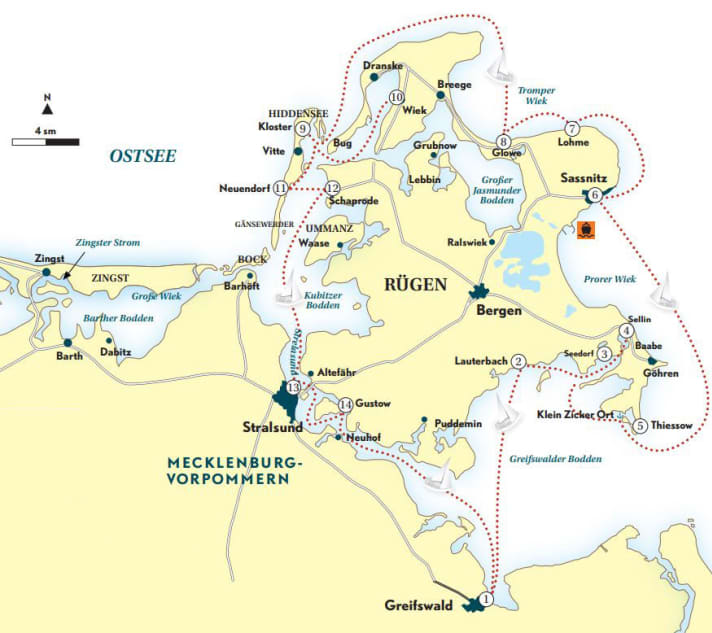
1 Greifswald
Founded in the Middle Ages, Greifswald is one of the oldest towns in northern Germany and is now home to the second oldest university in the Baltic Sea region. It is located on the navigable Ryck, which flows into the Danish Wiek in the south of the Greifswalder Bodden. You can sail up the river to the city centre; there are guest moorings on both banks. The Caspar David Friedrich Centre in Greifswald is well worth a visit. The most famous painter of German Romanticism was a son of the town and lived here mostly in abject poverty. If you are travelling along the Ryck towards the Bodden, you should stop off in Wieck after passing the wooden bascule bridge and visit the nearby Cistercian abbey of Eldena. The impressive monastery ruins were one of Caspar David Friedrich's and German Romanticism's favourite motifs.
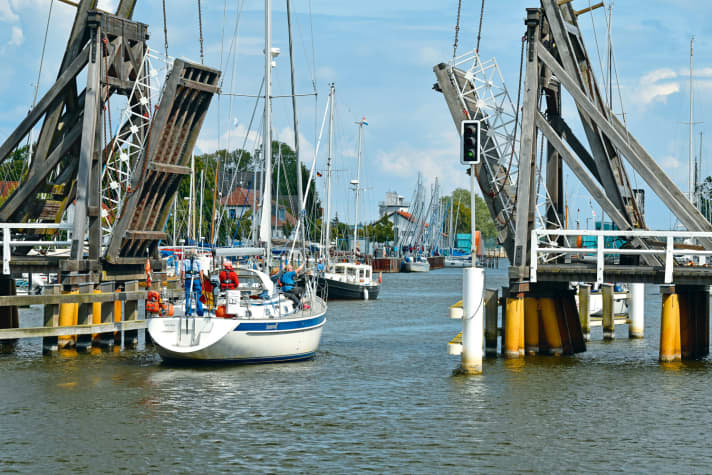
2 Lauterbach
The district on the north coast of the Greifswald Bodden is part of Putbus, the oldest seaside resort in Pomerania. Putbus was the residence of Prince Wilhelm Malte I and was built from 1810 in a strictly classicist style. In Lauterbach, yachts can moor in the northern part of the former fishing harbour. These jetties are managed by the Im-jaich marina, as is the entire neighbouring marina. Sailors will find all services for boat and crew here ( www.imjaich.de/urlaub/wasserferienwelt-ruegen ). It is only two kilometres from Lauterbach to Putbus. Worth seeing there is the classicist Circus, a circular square. There is also the orangery and the theatre. You can travel in style from Lauterbach-Mole to Putbus on the "Rasender Roland", Rügen's narrow-gauge steam railway. The route continues to the seaside resorts in the south-east of Rügen to Göhren ( www.ruegensche-baederbahn.de ).
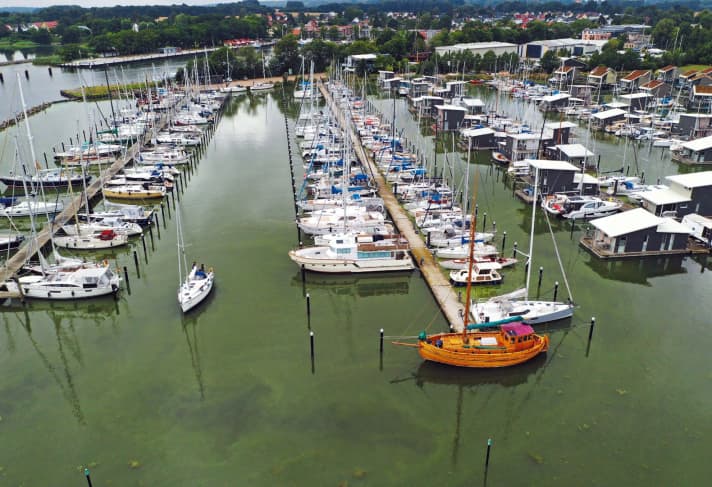
3 Seedorf
The most beautiful natural harbour on Rügen can be reached via the Having, which in turn is considered the most beautiful fjord on the Pomeranian coast. This part is part of the Unesco biosphere reserve of south-east Rügen. The associated restrictions - maximum speed five knots, no sailing in shallow water below two metres - should not be relevant for most sailors. In the centre of the Having, you head north into the Lanckener Bek towards Seedorf. The Swedish navy once used this unique natural harbour. In 1809, Prince Malte zu Putbus decided to settle fishermen, skippers and shipyards in Seedorf. The thatched houses on the eastern shore still characterise the image of the village today. There are guest moorings in the harbour in front of the pedestrian bridge ( www.hafen-seedorf-fewo. de ). The local smokehouse "De Seedörper" offers freshly caught fish from the smoke.
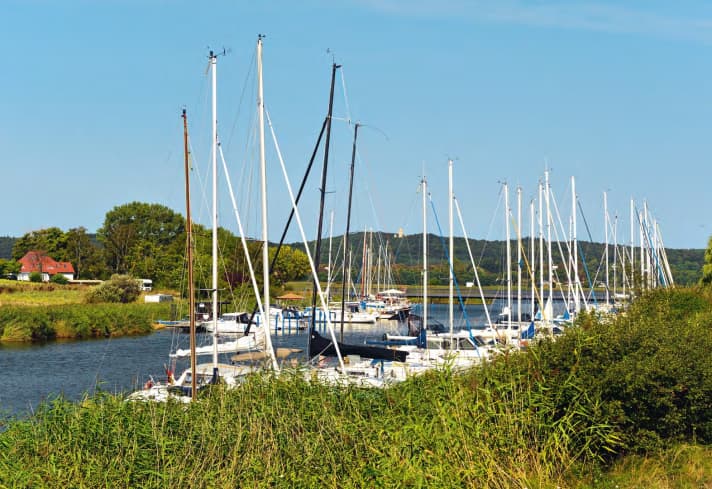
4 Sellin
A Bodden fairway lined with reed banks leads from the Having through the Baaber Bek and the Selliner See to the new Sellin water hiking rest area. A wonderful place, but be sure to keep to the fairway when approaching! The 20 metre wide dredged channel is officially two metres deep. Yachts with a greater draught have been seen here, but this is at your own risk. The new harbour was opened in 2018 and 80 guest yachts can moor there. There is a harbour office and sanitary facilities ( www.hafen-sellin.de ). From the jetties, you can walk about 600 metres to the Sellin railway station and take the "Rasender Roland" train to the Baltic seaside resorts of Baabe and Göhren. The Göhren Museum, where visitors can learn a lot about the history of the Mönchgut, is well worth a visit.
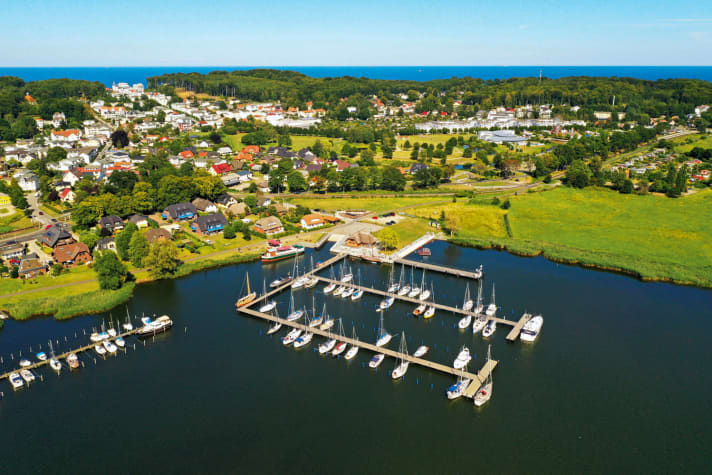
5 Klein Zicker
Crews will find one of the most beautiful natural moorings on Rügen at the entrance to Lake Zicker. Between the Groß and Klein Zicker peninsulas, a buoyed channel leads to the fishing harbour of Thiessow. The popular Klein Zicker Ort anchorage is on the starboard side at the entrance to Lake Zicker. If you arrive early, you can moor at one of the dolphins, which date back to the days of village shipping. Here you can moor safely and in the most beautiful solitude. In 1806, Swedish King Gustav Adolf IV wanted to build a fortress modelled on Karlskrona on the shore, with space for 400 warships, as well as barracks, shipyards, officers' houses and a maritime school. But nothing came of it: the French occupied Swedish West Pomerania a year later and destroyed the Swedish buildings. A few remnants can still be seen if you hike up the hill of Klein Zicker. From there, the view over the Mönchgut is fantastic.
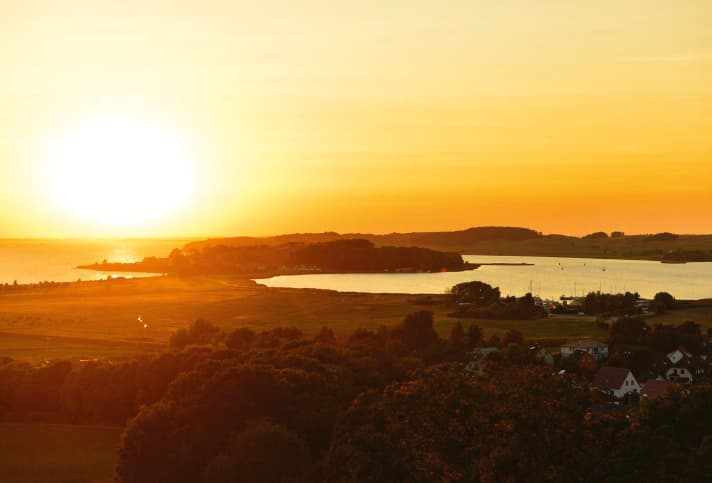
6 Sassnitz
The former ferry harbour of Rügen now mainly serves as a fishing harbour and pleasure craft marina. There are numerous restaurants along the pier, as well as a fishing and harbour museum. Thanks to the wide, lighted entrance, which is protected by high piers, Sassnitz can be called at in any weather ( www.stadthafen-sassnitz.de ). The location is ideal for visiting the famous chalk cliffs from here. From the entrance to the Jasmund National Park on the outskirts of Sassnitz, it is a two-kilometre walk to the Wissower Klinken. However, anyone expecting the view through the white pinnacles as painted by Caspar David Friedrich in 1818 will be disappointed: after the fall of the Berlin Wall, the Wissower Klinken still graced the cover of YACHT in 1990. However, on 24 February 2005, the fairytale chalk pinnacles slipped into the sea and were washed away by the Baltic Sea. It is easier to get to the Königsstuhl, which is a UNESCO World Heritage Site: Buses run from Sassnitz almost right up to the famous rock. There is currently a lot of construction going on there, but you are still allowed to enter the Königsstuhl. In future, there will be a futuristic viewing platform that will literally hover above the famous chalk cliff ( www.koenigsstuhl.com ).
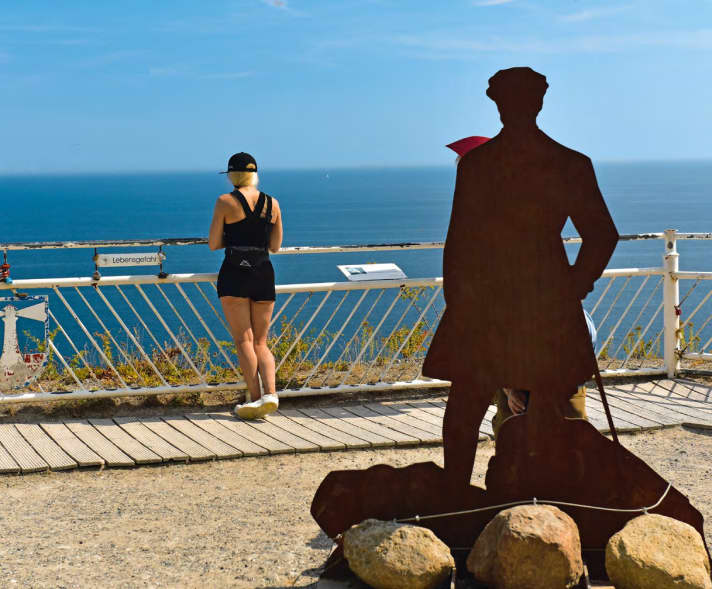
7 Lohme
The old fishing village is located at the northern end of the chalk coast. The harbour, which dates back to 1906, was modernised in 1997. There are not many berths, especially for larger yachts, so you have to arrive early or trust your luck. The village is 50 metres higher up and can be reached via a steep staircase. Once at the top, you will be rewarded with good fish dishes and a magnificent view in the "Am Meer" restaurant.
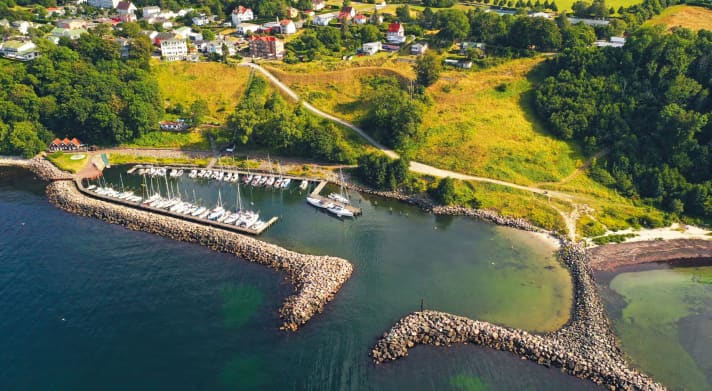
8 Glowe
The harbour of the fishing village, which was expanded into a marina in 2018, is the last mooring option before Cape Arkona. The harbour offers 190 berths with every comfort. Next to it is the wide sandy beach of Tromper Wiek ( www.glowe.de ). Buses run from Glowe to Cape Arkona, 20 kilometres away. It is the only cape on the German coast with three towers: the Schinkel tower, the lighthouse and the sounding tower. They and the once top-secret bunker of the GDR People's Navy can be visited ( www.kap-arkona.de ).
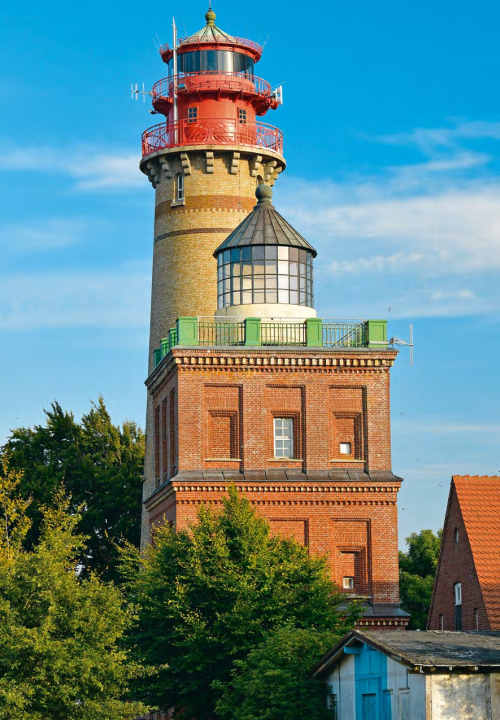
9 Monastery/Hiddensee
Kloster is the first port of call once you have rounded Cape Arkona in an east-west direction. The formerly small fishing harbour was extended to the south with new jetties in 2015. The entire facility has since been called Kloster Sailing Harbour and has space for 50 permanent berths and 120 guest yachts. There is electricity, water, Wi-Fi, showers, toilets, washing machines, dryers and a faeces extraction system ( www.seglerhafen-kloster.de ). Kloster is the cultural centre of Hiddensee. Particularly worth seeing are the island church, the Gerhart Hauptmann House and, of course, the lighthouse on the famous Dornbusch.
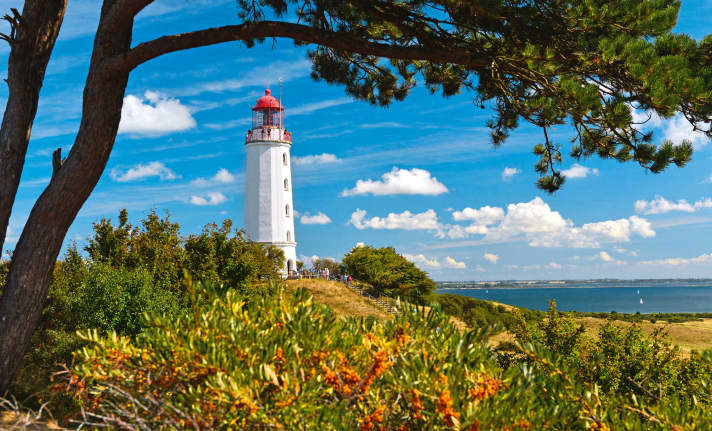
10 Wiek
The village is already located on the inner Bodden of Rügen and is accessed via the Wieker Bodden. Both the municipal harbour and the former chalk harbour with its striking loading bridge were extensively renovated after reunification. Today, the Wiek marina is located in the municipal harbour ( www.marina-wiek.de ), the harbour village of Wiek in the chalk harbour ( www.hafendorfwiek.de ). Both have a number of guest moorings with every comfort. The 14th-century St George's Church, not far from the jetties, is an outstanding example of North German brick Gothic architecture - a must-see!
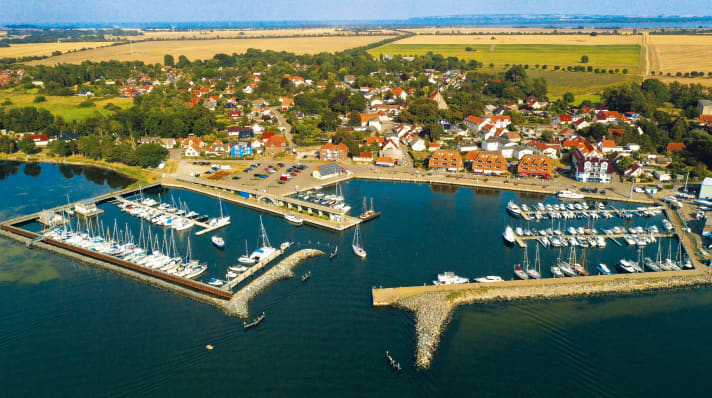
11 Neuendorf/Hiddensee
Back to the neighbouring island. Its southernmost harbour is divided into two parts: The southern basin is home to a waterway rest area with 50 guest berths. There is electricity, water, toilets, showers and a faeces disposal system. The northern part of the harbour is reserved for fishing boats. In between, ferries dock at the centre pier ( www.seebad-hiddensee.de ). There are several restaurants in the immediate vicinity of the harbour. The fishing museum in the former cage shed "Lütt Partie" is 500 metres away. The fine sandy beaches on the west coast are also only 600 metres away.

12 Schaprode
The town in the west of Rügen is home to the largest ferry harbour to Hiddensee. The marina is located further inland on the Schaproder Strom. It accommodates 220 permanent berths and guest yachts ( www.hafenschaprode.de ). Schaprode is also home to Yachtservice Rügen, which carries out repair and service work on boats ( www.yachtservice-ruegen.de ).
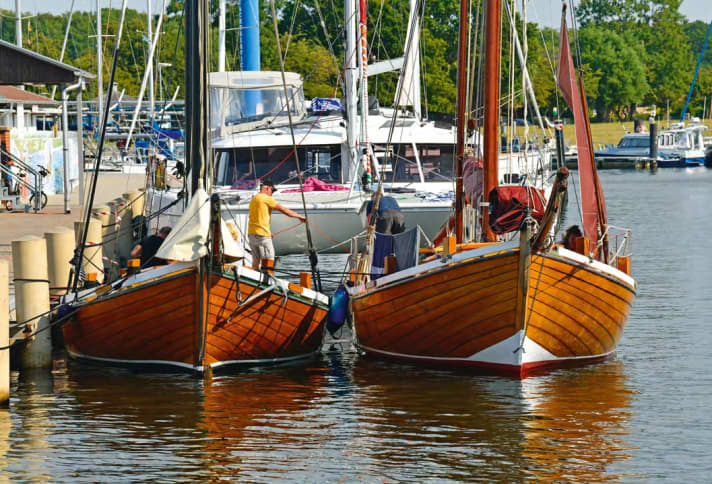
13 Stralsund
The Hanseatic city is not located on Rügen. However, anyone sailing around the island will inevitably sail through Stralsund's extensive harbour facilities. The city is also a cultural highlight with a number of sights. The best place for guests to moor is in the Citymarina and they are already in the city centre ( www.citymarinastralsund.de ). The old town centre has been a Unesco World Heritage Site since 2002. Around the market square, the Swedish Commander's House is a reminder that the city once belonged to Sweden. You should also pay a visit to the imposing Nikolai Church. In the harbour, you can visit the old "Gorch Fock I" from 1933, which sailed under the Soviet flag as the "Towarisch" after the Second World War ( www.gorchfock1.de ). The city's big attraction is the Ozeaneum, for which you should plan half a day ( www.ozeaneum.de ). Housed in a former monastery in the city, the maritime museum is currently being remodelled and is scheduled to reopen in 2024 ( www.meeresmuseum.de ).
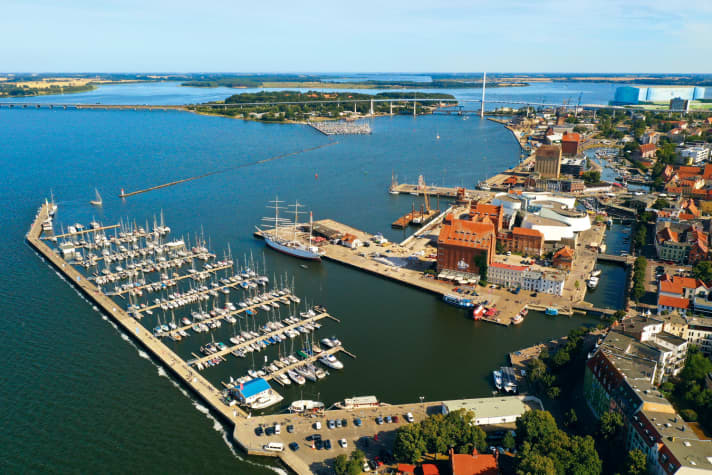
14 Gustow
If you are looking for peace and quiet after the hustle and bustle of Stralsund, Gustow, not far away, is just the place for you. The small marina in the north of the Gustower Wiek is a paradisiacally peaceful natural oasis. Nevertheless, it is a cosy place: The harbour master's house has a bistro serving beer and delicious tarte flambée ( www.im-jaich.de/hafen/heimathafen-gustow ). There is a sandy beach 400 metres away for swimming.
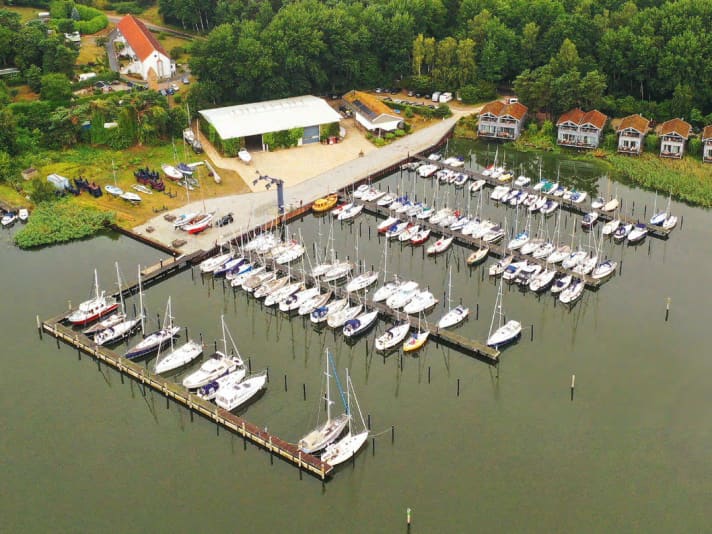
Charter providers, cruising guides and nautical charts
Charter (selection)
- Mola Yachting in Breege on the island of Rügen, www.molayachtcharter-ostsee.de
- Strelasund yacht charter in the cross channel of Stralsund, www.strelasundyachtcharter.de
- 1st class yachts/yacht and charter centre in the Marina Greifswald, www.charterzentrum.de
- Mediamare Yachtcharter in the Marina Kröslin, www.mediamare-yachtcharter.de
Literature & Maps
- Michael Brandenburg: " Mecklenburg-Western Pomerania Coastal Handbook ", 39.90 euros, published by Edition Maritim
- Jan Werner: " Cruising guide Baltic Sea coast 2 - Wismar to Szczecin ", Delius Klasing Verlag, 39.90 euros
- " Coastal guide around Rügen ", nautical atlas based on nautical charts with superimposed harbour plans, 34.90 euros, Edition Maritim
- Recreational craft chart set 2: " Mecklenburg-Western Pomerania - Bornholm ", Delius Klasing, 74,90 Euro

